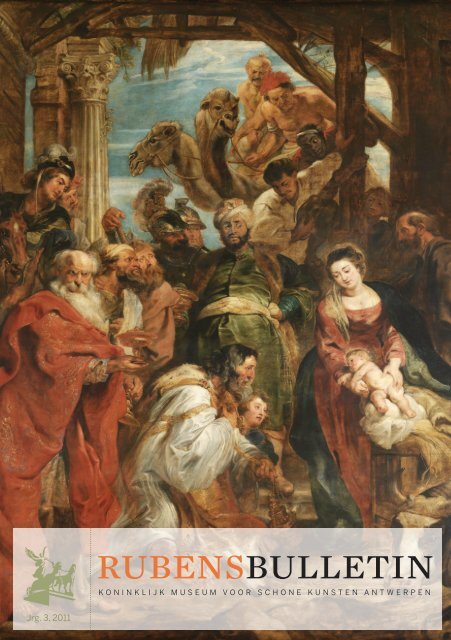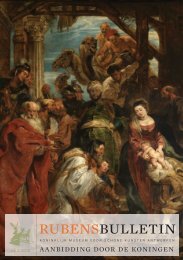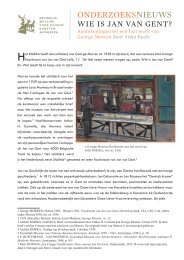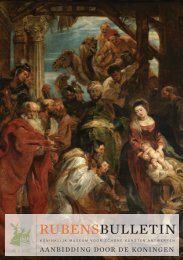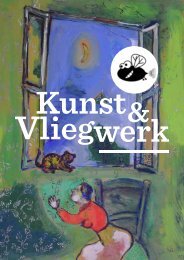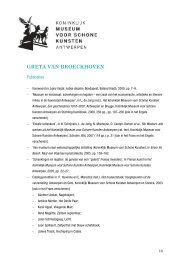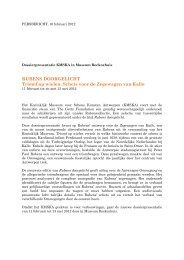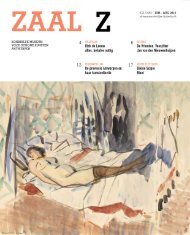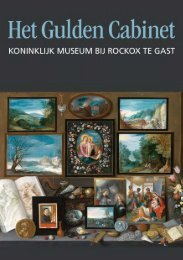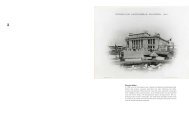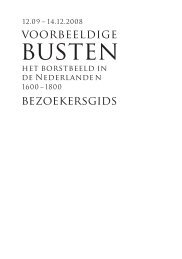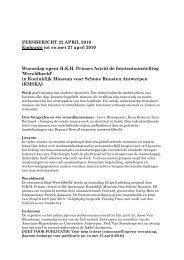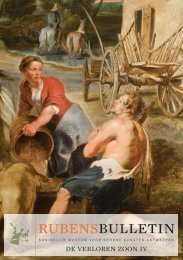Triumph In Antwerp Rubens's oil Sketch - Koninklijk Museum voor ...
Triumph In Antwerp Rubens's oil Sketch - Koninklijk Museum voor ...
Triumph In Antwerp Rubens's oil Sketch - Koninklijk Museum voor ...
Create successful ePaper yourself
Turn your PDF publications into a flip-book with our unique Google optimized e-Paper software.
BULLETIN<br />
rubensbulletin<br />
KONINKLIJK MUSEUM VOOR SCHONE KUNSTEN ANTWERPEN<br />
Jrg. 3, 2011<br />
1
BULLETIN<br />
BULLETIN<br />
<strong>Triumph</strong> in <strong>Antwerp</strong><br />
Rubens’s <strong>oil</strong> sketch The <strong>Triumph</strong>al Chariot of Kallo<br />
Ank Adriaans-van Schaik<br />
<strong>In</strong>troduction<br />
Fig. 1 Peter Paul Rubens, The <strong>Triumph</strong>al Chariot of Kallo, 1638, KMSKA<br />
The city of <strong>Antwerp</strong> boasts a long tradition of festive ceremonies, among<br />
them the Ommegang processions and the Blijde <strong>In</strong>komsten, state entries<br />
of new rulers. Such Joyous Entries took place as early as the sixteenth<br />
and seventeenth centuries. The <strong>Antwerp</strong> festival books display printed<br />
illustrations of the splendid city decorations. The annual procession, the<br />
Ommegang, a parade including both religious and secular themes, even<br />
dates back to the fourteenth century. The date of the Joyous Entry was<br />
determined by the first visit of a new ruler, while the Ommegang was<br />
organized according to the religious calendar. <strong>In</strong> short, the people of<br />
<strong>Antwerp</strong> were used to regular festive events.<br />
<strong>In</strong> the summer of 1638, however, an unprecedented spontaneous<br />
celebration took place, caused by the news of the victory of the Spanish<br />
army against the Dutch in the nearby village of Kallo. <strong>In</strong> the atmosphere<br />
of triumph, the city government decided to commemorate this victory as<br />
well as another military success obtained a few days later at Saint-Omer by<br />
commissioning a festive float intended to ride in the <strong>Antwerp</strong> Ommegang.<br />
They assigned the task of designing a triumphal chariot to Peter Paul Rubens<br />
(1577– 1640), who had been responsible for the city decorations three years<br />
before, in 1635, when the <strong>Antwerp</strong> government had invited Cardinal-<br />
<strong>In</strong>fante Ferdinand to make his Joyous Entry into the city. Rubens’s design<br />
– an <strong>oil</strong> sketch – for The <strong>Triumph</strong>al Chariot of Kallo, an allegory of triumph,<br />
is filled with personifications and mythological figures (fig. 1).<br />
The triumphal chariot is designed in the shape of a ship whose mast<br />
is replaced by a huge trophy. The chariot is driven by Providentia Augusta.<br />
Behind her the city maidens of <strong>Antwerp</strong> and Saint-Omer – Antverpia<br />
and Audumarum – are kneeling. Virtus and Fortuna, the personifications<br />
of courage and fortune, can be seen at the stern of the ‘naval chariot’.<br />
41
BULLETIN<br />
BULLETIN<br />
Prisoners at the base of the trophy symbolize the defeated enemy, whereas<br />
winged Victories and Fama announce the military triumph.<br />
The iconography of Rubens’s <strong>oil</strong> sketch will be dealt with more<br />
extensively in a sequel to the present article in the next issue of the<br />
Rubensbulletin. The present contribution discusses the commission of<br />
Rubens’s <strong>oil</strong> sketch starting from the historical context of the Eighty Years<br />
War and explains the intensity of the festivities following the victory of<br />
Kallo. Subsequently, the tradition of the <strong>Antwerp</strong> Ommegang will be<br />
analysed. And, finally, we will take a close look at the text of a seventeenthcentury<br />
manuscript about the kind of parade for which Rubens’s triumphal<br />
chariot was meant.<br />
The content of this article is partly based on chapters 2 and 4<br />
of my thesis Rubens’s <strong>oil</strong> sketch The <strong>Triumph</strong>al Chariot of Kallo. Ancient<br />
triumph and <strong>Antwerp</strong> festive tradition. New information resulting from the<br />
preparation of an exhibition on the subject has also been included under<br />
the heading ‘<strong>Triumph</strong> in the City’. 1<br />
Northern Provinces decided to blockade the river Scheldt as an answer to<br />
the Spanish economic embargo that was disadvantageous to Dutch trade. 2<br />
The overseas commerce that had made <strong>Antwerp</strong> the greatest port in Europe<br />
began to decline because maritime traffic was not allowed free passage to<br />
the city. From 1585 onwards the goods arriving at the mouth of the river<br />
Scheldt had to be unloaded at the Zeeland ports, which now replaced<br />
<strong>Antwerp</strong> as the primary port of discharge on the Scheldt. 3 The economic<br />
decline of the city caused a huge exodus of refugees, who moved from<br />
the Southern Provinces to the North. Thousands of the many Protestant<br />
inhabitants of <strong>Antwerp</strong>, including workers, merchants and artists, settled<br />
in the cities of Haarlem, Amsterdam and Leiden. The Dutch blockade was<br />
not the only cause of <strong>Antwerp</strong>’s decline, though. The Spanish restrictions<br />
on commerce and the obligatory toll collection disadvantaged <strong>Antwerp</strong>’s<br />
trade even more than they hit the commerce of the Northern Provinces. 4<br />
The signing of the Twelve Years’ Truce (1609–21) revived the hope<br />
of reopening the Scheldt. The city government commissioned the painting<br />
Scaldis and Antverpia for the state room or Staetencamer of <strong>Antwerp</strong>’s<br />
The Eighty Years War and the blockade of the river Scheldt<br />
The city of <strong>Antwerp</strong> had been rich and prosperous in the sixteenth century,<br />
an era that has often been characterized as <strong>Antwerp</strong>’s Golden Age. The<br />
fact that around mid-century the size of <strong>Antwerp</strong>’s trade activity even<br />
surpassed that of Venice is telling evidence of the city’s former wealth.<br />
However, <strong>Antwerp</strong>’s fortunes changed when the Northern Netherlands<br />
began to revolt against Philip II of Spain. This revolt marked the beginning<br />
of the Eighty Years War (1568–1648), which was to separate the Protestant<br />
Northern Netherlands from the Catholic Southern Netherlands ruled<br />
by Spain. The economic situation of <strong>Antwerp</strong> changed dramatically as a<br />
consequence of the Spanish recapture of the city by Alexander Farnese<br />
in 1585. Since the ‘Fall of <strong>Antwerp</strong>’, as this episode came to be known, the<br />
Fig. 2 Abraham Janssen, Scaldis and Antverpia, 1609, KMSKA<br />
1<br />
Adriaans-van Schaik 2011. The exhibition ‘<strong>Triumph</strong> on Wheels, Rubens’s <strong>oil</strong> sketch The <strong>Triumph</strong>al<br />
Chariot of Kallo’, will take place at the <strong>Museum</strong> Rockoxhuis, <strong>Antwerp</strong>, February–May 2012.<br />
2<br />
The Spanish rulers decreed commercial embargoes on Dutch trade in 1585–90, 1598–1608 and<br />
1621–47; see Israel 1991, p. 9.<br />
3<br />
Ibid., p. 30.<br />
4<br />
Prims et al. 1927.<br />
42<br />
43
BULLETIN<br />
BULLETIN<br />
city hall from Abraham Janssen (1573–1632) in 1609 (fig. 2). 5 This painting<br />
symbolizes the value of the river Scheldt for the city’s welfare and reflects<br />
faith in the restoration of its wealth. However, the truce did not bring any<br />
improvement as <strong>Antwerp</strong>’s access to the sea remained under the control of<br />
the Dutch patrols.<br />
The Battle of Kallo<br />
The Dutch stranglehold on the city had been consolidated in 1585, when<br />
the Spanish troops failed to clear the Dutch from the Scheldt estuary.<br />
<strong>In</strong> 1638, however, the victory at Kallo changed the city’s perspective for<br />
a short period of time. When the Dutch troops were defeated, it looked<br />
as if <strong>Antwerp</strong> were finally ready to resume overseas trade and economic<br />
recovery were imminent. But who could have foreseen that history would<br />
take an other turn for the worse and that ten years later the Peace of<br />
Fig. 3 Map of the fortress of Kallo, published by<br />
Joannes Meyssens, <strong>Antwerp</strong> s.a.<br />
Fig. 4 The failed attack of Count William of Nassau on the fortification of Kallo, etching<br />
Münster (1648) would ratify Dutch mastery of the Scheldt estuary? A<br />
closer look at the course of the Battle of Kallo should clarify the historical<br />
context of Rubens’s design for a triumphal chariot celebrating this victory<br />
gained on the borders of the Scheldt.<br />
After the reconquest of Breda by the Dutch in 1637, the capture of<br />
<strong>Antwerp</strong> was the primary objective of Prince Frederick Henry’s strategy in<br />
the revolt of the Northern Netherlands against Spain. 6 <strong>In</strong> 1638, on their first<br />
campaign after retaking Breda, the Dutch armies moved in the direction of<br />
the river Scheldt (fig. 3).<br />
Despite Frederick Henry’s objections about the moment of attack,<br />
the Dutch deputies and the French allies ordered an immediate raid on the<br />
city of <strong>Antwerp</strong> in June. As a result, Frederick Henry sent the experienced<br />
field marshal Count William of Nassau-Siegen and his six thousand men<br />
in advance to capture the left riverbank, especially the embankment at<br />
Kallo, from where the citadel of <strong>Antwerp</strong> had to be taken. It was planned<br />
that Frederick Henry and his troops would aim for Berchem and that the<br />
combined armies would besiege the city. However, the planned attack<br />
turned into a disaster for the Dutch troops (fig. 4).<br />
William of Nassau managed to occupy the forts of Kallo and<br />
Verrebroek, though not without casualties, as he lost many of his men in the<br />
slush of the wetlands. The two Dutch armies did not meet in accordance<br />
with their military plans, because William decided to stay at Kallo and<br />
5<br />
Panel, 1609, 174 × 308 cm, KMSKA, inv. 212. The Staetencamer of the city hall was the place where<br />
the peace negotiations between the Northern and Southern Netherlands were held. Nico Van Hout,<br />
in Huvenne 2003, p. 86.<br />
6<br />
Blok 1924, p. 210.<br />
44<br />
45
BULLETIN<br />
BULLETIN<br />
Frederick Henry waited in vain to get a message from his field marshal. 7<br />
Cardinal-<strong>In</strong>fante Ferdinand’s strategy of obstructing the meeting of the<br />
two armies by ordering an immediate attack of the Dutch troops appears<br />
to have been a stroke of luck. The Spanish troops attacked the enemy in the<br />
back lines, while the Dutch tried in vain to withdraw to Fort Liefkenshoek.<br />
The Dutch armies took severe losses: many were killed, wounded or<br />
captured in battle, or they drowned in the wetlands. The attack on <strong>Antwerp</strong><br />
had failed, and in the course of time Frederick Henry’s defeat (one of the<br />
few) seems to have been forgotten in favour of his victories described in<br />
the Dutch history books.<br />
The victory at Kallo was one of Cardinal-<strong>In</strong>fante Ferdinand’s greatest<br />
military exploits. The estimated number of Dutch casualties was about<br />
two thousand, while twelve hundred had been taken prisoner. The Spanish<br />
troops under the command of the Marquis de Leede took eighteen cannon,<br />
eighty ammunition boats, two pontoon bridges and two cannon sloops. 8 On<br />
top of this victory, Ferdinand’s troops commanded by Prince Thomas of<br />
Carignan and Count Piccolomini defeated Frederick Henry’s French allies<br />
at Saint-Omer a couple of days later.<br />
belonged to the armies of the Prince of Orange. The pilgrimage lasted for<br />
nearly eight days. After the battle, the captured Dutch ships were moored<br />
at the Scheldt docks and at the Engelse Kaai, where they were admired by<br />
the excited crowd. 9<br />
Immediately, the victory at Kallo was con sidered a miracle due<br />
to the interference of the Holy Virgin. Rumour had it that William of<br />
Nassau-Siegen’s son Maurice had found a statuette of Our Lady in the<br />
church of Kallo, that he mocked it and burned it in a fire, while at the<br />
same time ridiculing the images of the apostles Peter and Paul. The<br />
death of Maurice and the defeat of the Dutch troops were believed to be<br />
the punishment for this mockery. The pamphlet in question is not the<br />
only source of this rumour, for the story is also referred to in a letter by<br />
Balthasar Moretus I to his nephew Theodoor, a professor in Prague, in a<br />
letter dated 25 June 1638. 10<br />
The story seems to have had an impact on the emotions caused by<br />
the victory. The Cardinal-<strong>In</strong>fante in person was present at the Te Deum in<br />
<strong>Antwerp</strong> Cathedral celebrating the victory, which was attended by a huge<br />
<strong>Triumph</strong> in the city<br />
The victory at Kallo caused unprecedented euphoria in the city of <strong>Antwerp</strong>,<br />
and the Spanish successes were celebrated as a miracle. News of the victory<br />
reached <strong>Antwerp</strong> early in the morning of 22 June 1638 and, according to<br />
a popular pamphlet describing the events, immediately brought about a<br />
pilgrimage to the battlefield. The pamphlet reports a jubilation beyond<br />
words spreading among the citizens of <strong>Antwerp</strong>. The news encouraged<br />
many of them to walk to Kallo in order to see the place of the ‘heavenly<br />
triumph’ and bring back as battlefield relics the orange garlands that had<br />
7<br />
Blok 1924, p. 212.<br />
8<br />
Génard 1888, p. 158. According to Sabbe (1929, p. 276; and 1933, chapter 17), three thousand troops<br />
were killed and three standards, fifty banners, twenty-six field cannons, two frigates, two pontoon<br />
bridges and eighty vessels loaded with food and ammunition were captured.<br />
9<br />
The 1638 pamphlet is quoted by Sabbe 1933, p. 385: ‘Den seghe-riicken/ Triomph-boghe/ oft<br />
beschriivinge/ van de victorien vercregen/ tegen de Hollanders/ in ‘t Landt van Waes,/ ende/ teghen<br />
de Fransoysen/ <strong>voor</strong> S. Omer. Midtsgaders van de victorien teghen deselve Fransoysen in Italien<br />
ende Elzas’ (T’Hantwerpen By Martinus Binnart, inde Hoogstraet inde Bonte Koeye, Anno 1638.<br />
Cum consensu superiorum): ‘De tijdinghe van dese victorie den 22. ‘s morghens heel vroegh binnen<br />
<strong>Antwerp</strong>en ghekomen zijnde/ heeft sulck een blijdschap onder de borgherije ghemaeckt/ dat die<br />
met gheen penne en kan beschreven worden. Ja ontallycke menschen zijn terstonde naer Calloo<br />
gheloopen/ om te sien de plaetse van dese hemelsche victorie; van waer schier niemandt weder<br />
en quam/ oft sy brochten iet mede van des vijandts reliquien. Vele hebben orange-sluyers mede<br />
ghebrocht/ daer mede comende over de brugghe braveren: ende schier acht daghen langh heeft dese<br />
pelgrimagie gheduert. . . . Doen wierden oock de veroverde schepen de Schelde op aen de Werf ende<br />
Engelsche kaeye ghebrocht/ die de borgherije quam sien met een ongheloovelijcke menighte ende<br />
blydschap.’<br />
10<br />
The issue was mentioned in the pamphlet (see note 9): ‘. . . want hy hadde daeghs te voren inde<br />
Kercke buyten Calloo doen op het vier smijten ende verbranden het beeldt van de weerdighe<br />
Moeder Godts Maria/ met de selve gheckende ende spottende/ waerom dat sy niet was wrekende<br />
het onghelyck dat men haer aen dede: hadde oock doen in stucken kappen de beelden van<br />
S.S. Peeter ende Pauwels Patroonen van de selve Kercke/ met vele byghevoeghde blasphemien ende<br />
Godtslasteringen: welck allegader met syne ooghen aenghesien heeft den tambour majeur van Sinte<br />
Marie . . .’ Sabbe 1933, p. 386.<br />
46<br />
47
BULLETIN<br />
BULLETIN<br />
crowd. 11 According to Maurits Sabbe, not only the people of <strong>Antwerp</strong> but<br />
even the Cardinal-<strong>In</strong>fante himself attributed the victory to the Holy Virgin<br />
and St Aloysius Gonzaga.<br />
Cornelis Galle II’s (1615–1678) engraving Ferdinand receiving the<br />
sword in order to defeat the Dutch Armies at Kallo (1638) represents the<br />
religious feelings related to the victory at Kallo (fig. 5). 12 The image depicts<br />
the governor of the Spanish Netherlands kneeling, while the Virgin and<br />
Child enthroned in heaven are surrounded by St Peter, St Paul and the<br />
angels. Ferdinand receives the sword from the hands of St Paul. <strong>In</strong> the<br />
background, the Dutch soldiers under the command of Count William of<br />
Nassau-Siegen are taking to flight after the failed<br />
attack on Fort Kallo. The engraving was made after<br />
the altarpiece by Theodoor van Thulden (1606–<br />
1669) that once adorned the Church of St Peter<br />
and St Paul at Kallo. 13 The high altar, which was<br />
replaced by a late baroque construction designed<br />
by Cornelis Struyf, in about 1734–40, probably<br />
disappeared from the church, together with<br />
Van Thulden’s altarpiece (present whereabouts<br />
unknown), at the time of the French occupation. 14<br />
A copper coin commemorating the Battle of Kallo<br />
was issued in Brussels in 1638. On the obverse is<br />
Fig. 5 Cornelis Galle II,<br />
Tabula summi altaris<br />
ecclesiae parochialis in Calloo,<br />
1638, engraving, <strong>Antwerp</strong>,<br />
<strong>Museum</strong> Plantin-Moretus/<br />
Prentenkabinet<br />
Philip IV of Spain on horseback, while the reverse<br />
shows a ship nearly capsizing in the waves. The<br />
coin was minted in honour of the sovereign, instead<br />
of representing his brother Cardinal-<strong>In</strong>fante Ferdinand,<br />
the commander of Philip’s troops, which<br />
11<br />
Sabbe 1929, p. 277.<br />
12<br />
Tabula summi altaris ecclesiae parochialis in Calloo, 1638, engraving, 259 × 179 mm; <strong>Museum</strong><br />
Plantin-Moretus/Prentenkabinet, <strong>Antwerp</strong>, inv. PK.OP.12922.<br />
13<br />
According to Frederik Muller, the engraving is after the altarpiece that used to be in the church<br />
of Kallo. See F. Muller, De Nederlandsche geschiedenis in platen: beredeneerde beschrijving van<br />
Nederlandsche historieplaten, zinneprenten en historische kaarten, 4 vols., Amsterdam 1863–82, IV,<br />
pp. 187–188, no. 1786B.<br />
14<br />
I owe this information to Dr Claire Baisier, curator of the <strong>Museum</strong> Mayer van den Bergh, <strong>Antwerp</strong>.<br />
Fig. 6 Pieter Snayers, The Battle of Kallo,<br />
1638, Brussels, <strong>Koninklijk</strong>e Musea<br />
<strong>voor</strong> Schone Kunsten van België/Musées<br />
Royaux des Beaux-Arts de Belgique<br />
emphasizes the political weight attached<br />
to the victory by the Spanish<br />
king. The significance of this military<br />
success is further corroborated, for that<br />
matter, by the fact that the battle was<br />
commemorated in several works of art.<br />
The painter Pieter Snayers (1592–after<br />
1666) specialized in battle scenes, espe<br />
cially the historical sieges of contemporary<br />
conflicts. 15 As court painter<br />
to the Cardinal-<strong>In</strong>fante, he made a<br />
visual report of the Spanish military<br />
success (fig. 6). The battlefield is rendered<br />
in a bird’s-eye view showing the polders and dykes, while the outline<br />
of <strong>Antwerp</strong> is vaguely visible in the upper right corner. A similar painting<br />
of the battle by the brothers Bonaventura (1614–1652) and Gillis Peeters<br />
(1612–1653) is in the <strong>Museum</strong> Vleeshuis, <strong>Antwerp</strong>. 16<br />
The <strong>Antwerp</strong> Ommegang<br />
From the fourteenth century onwards, religious processions had become<br />
an increasingly important part of European church rituals, but they were<br />
also prone to secularization. Italian processions at Carnival and the feast<br />
of Corpus Christi set the pattern. Starting in the quattrocento, the religious<br />
procession accompanying a popular festival soon developed into the trionfo<br />
(triumph; triumphal procession; also float in such a procession), consisting<br />
of groups of masked figures walking on foot or carried in chariots. 17 Soon<br />
enough the secular trionfo, modelled on the parade of the Roman Imperator,<br />
became far more frequent than its religious counterpart. Knowledge of<br />
15<br />
Vlieghe 1998, pp. 172, 173.<br />
16<br />
The Battle of Kallo on 21 June 1638, 1638–53, canvas, 263.5 × 379.5 cm, <strong>Museum</strong> Vleeshuis, <strong>Antwerp</strong>.<br />
17<br />
Burckhardt (1990, p. 256) argued that the ecclesiastical nature of the Italian procession soon gave<br />
way to a secular character.<br />
48<br />
49
BULLETIN<br />
BULLETIN<br />
the classical triumphus was derived from ancient reliefs and the writings<br />
of classical authors. If there were no military victories to celebrate, the<br />
festive procession might also be organized for its own sake.<br />
<strong>In</strong> the cities of the Southern Netherlands, the Ommegang had<br />
been a highlight of the festive calendar from the Middle Ages. Tableaux<br />
vivants on the cars of the processions commemorated religious festivals,<br />
especially that of Corpus Christi. 18 The word Ommegang (walk-round)<br />
derives from the habit of carrying the relic of a saint, mostly the patron<br />
of the local church, through the parish streets, which characterized the<br />
earliest ceremonies. <strong>In</strong> <strong>Antwerp</strong> the tradition is believed to go back to<br />
the end of the thirteenth or the beginning of the fourteenth century. The<br />
earliest account of an Ommegang has been found in a document from 1324<br />
in the <strong>Antwerp</strong> city archives. 19 The oldest known <strong>Antwerp</strong> ordinancie, a<br />
ceremonial booklet describing the Ommegang, is dated 1398. It informs<br />
us about the arrangement of the procession accompanying the relic of the<br />
Holy Circumcision. The annual procession celebrating the feast of the<br />
Holy Sacrament or Corpus Christi originated in <strong>Antwerp</strong> between 1324<br />
and 1398. The procession in honour of Our Lady, the Onze Lieve Vrouwe<br />
Ommegang, which took place on the Sunday after the Assumption of the<br />
Holy Virgin, was first mentioned in the municipal accounts of 1399.<br />
The 1398 ordinancie describes the procession in detail. First came<br />
the artisans, grouped according to their crafts. These were followed by<br />
poyncten (points or acts), performances of Old and New Testament stories<br />
and similar narratives, including Jacob’s Dream, The Twelve Apostles and<br />
St Christopher, and the Annunciation. 20 Next to the poyncten came the<br />
regular and secular clergy, then the archers’ guilds, the cloth guild with<br />
the four candles, the city pipers, the burgomasters and aldermen, and the<br />
bailiff. The prelates at the end of the procession accompanied the relic of<br />
the Holy Circumcision. The carrying of the relic was the privilege of the<br />
prelate of St Michael’s Abbey; the canopy over it was carried by six ‘good<br />
boys’. The religious part of the Onze Lieve Vrouwe Ommegang presented six<br />
18<br />
McGrath 1975.<br />
19<br />
Prims 1949, p. 7.<br />
20<br />
De Burbure 1878, pp. 2–5, and Prims 1949, p. 7.<br />
scenes related to the life of the Virgin: Annunciation, Visitation, Nativity,<br />
Adoration of the Magi, Seven Sorrows and Seven Joys of the Virgin, and the<br />
Virgin’s Assumption or her Coronation. The representation of the triumph<br />
of Christ in the Last Judgement completed the religious section.<br />
Secular influence was present from the outset in these <strong>Antwerp</strong><br />
processions, just as in Italy. Worldly subjects, such as the rep resentation of<br />
the sovereigns, the Dukes of Brabant, mingled with religious themes from<br />
the very beginning. The ordinancies of the Circumcision processions of<br />
1398 and 1494 report the use of costumes. 21 <strong>In</strong> the course of the fifteenth<br />
and early sixteenth century, however, this secular influence gradually became<br />
more apparent. 22 Symbolic themes and allegories in spired by humanism<br />
increasingly replaced the earlier, more realistic performances.<br />
The poyncten featuring costumed players developed into dialogues<br />
and pageant plays influenced by the camers van rhetorike or chambers<br />
of rhetoric. Little by little biblical subjects were transformed into more<br />
worldly themes. The biblical giant Goliath turned into the city giant<br />
‘Druon Antigon, and the ‘Whale’ that once spat out Jonah later carried a<br />
Cupid handling a water syringe. The ‘Maidens’ Car’ no longer referred to<br />
the biblical parable of the wise and foolish virgins. And the ‘Camel’ broke<br />
loose from its original group of the Adoration of the Magi.<br />
During the sixteenth and seventeenth centuries the Ommegang<br />
consisted of a series of traditional secular items staged on some ten cars,<br />
followed by the religious section, but floats featuring new and topical<br />
items were added on a regular basis. 23 These new, worldly themes often<br />
had a moralizing character, for instance ‘The Course of the World in Seven<br />
Figures’ (1561), ‘The Theatre of the World’ (1564) and ‘The Present Time’<br />
(1566). 24 According to the ordinancie of the Onze Lieve Vrouwe Ommegang<br />
of 1564, the secular themes started with ‘Portunus’, the Roman god of<br />
harbours, riding naked on a sea horse and presented as the servant of<br />
21<br />
De Burbure 1878, pp. 10, 11, 12. About the relation between the Ommegang and the chambers<br />
of rhetoric, see also Van Bruaene 2008, pp. 27–50.<br />
22<br />
Prims 1949, p. 10.<br />
23<br />
Prims 1949, pp. 11–21.<br />
24<br />
Joukes 1990, pp. 167–172; Thøfner 2007, p. 162.<br />
50<br />
51
BULLETIN<br />
BULLETIN<br />
‘Neptune’, god of the seas, who followed him, seated on a sea monster<br />
more than thirty feet long. ‘Nereus’ and ‘Doris’, representing the meeting<br />
of the salt sea and fresh water, were accompanied by water creatures<br />
dressed in iris and reed. The ‘Elephant’ carrying ‘Fortune’ on its back<br />
was followed by a big giant accompanied by smaller giants as well as by<br />
‘Brabon’, who carried the giant’s cut hand on his sword and the ‘Ship’ of<br />
the traders’ guild. The final secular theme was that of the ‘City Maiden<br />
of <strong>Antwerp</strong>’, who was accompanied by ‘Scaldis’, the personification<br />
of the river Scheldt; ‘Mercury’, the god of commerce; ‘Copia’, the<br />
personification of abundance; and by boys and girls carrying all kinds<br />
of jewellery. After 1564, the topics of ‘Mount Parnassus’ featuring the<br />
nine ‘Muses’ and the ‘Mountain of Maidens’ were added. New subjects<br />
were explained by means of texts on boards or in a printed booklet. The<br />
oratuer preceded the poyncte and recited verses introducing it, while boys<br />
carried text boards elucidating the subject or containing a suitable motto.<br />
The personifications or allegorical figures were identified by labels at<br />
their feet or by banderoles held by angels. Printed ordinancien that were<br />
offered for sale, described the annually recurring ‘points’ and explained<br />
the new ones.<br />
No longer restricted to religious feasts, the Ommegang began to be<br />
used to intensify the festive spirit of a Joyous Entry or the celebration of a<br />
victory. Political motives thus also encouraged the creation of new floats.<br />
<strong>In</strong> 1609 the Twelve Years’ Truce inspired four new themes, including ‘Pax<br />
ende Iusticia’ or ‘Peace and Justice’; ‘Mercury’, symbolizing the much<br />
hoped-for restoration of commerce; and the ‘Forge’, in which the armour<br />
was reforged into household and farming equipment (braetpannen ende<br />
ploeghysers, pots and iron ploughs). 25 The fourth new theme was a scene<br />
in which men and women were seated at a round table while a good<br />
dinner was being served. <strong>In</strong> 1619 the Truce inspired the theme ‘Alliance<br />
et confédération Belgique’, 26 presenting the Archduke closing the Temple<br />
of Janus.<br />
This newly-established tradition of adding topical political subjects<br />
to the traditional poyncte of the Ommegang provided the context in which<br />
Rubens was commissioned by the <strong>Antwerp</strong> city government to design a<br />
triumphal chariot commemorating the politically significant military<br />
victories at Kallo and Saint-Omer. 27 Despite the fact that it took part in the<br />
Ommegang, Rubens’s waghen triumphael celebrated this wordly triumph<br />
that was so important to <strong>Antwerp</strong> while at the same time paying tribute<br />
to the city that commissioned it and to its conqueror, Cardinal-<strong>In</strong>fante<br />
Ferdinand.<br />
Joyous Entries<br />
During the sixteenth and seventeenth centuries Italian, Spanish and French<br />
as well as Northern European cities organized triumphal celebrations.<br />
These festivals took place in such cities as Rome, Ferrara, Venice, Genoa,<br />
Nuremberg, Ghent, Bruges and <strong>Antwerp</strong>. <strong>In</strong> these magnificent entries the<br />
sovereign played the leading role, irrespective of whether he was the pope<br />
or the emperor, or a doge, duke, prince or king. The decorated cities and<br />
their ephemeral structures formed the setting in which the ceremonies<br />
were staged. Often the triumphal entry expressed the special bond between<br />
the city and the ruler. <strong>In</strong> the Southern Netherlands, a political protocol<br />
was typically part of the ritual.<br />
Ever since the time of the dukes of Burgundy, new governors had<br />
been invited to make their Blijde <strong>In</strong>komst in the major cities of the Southern<br />
Netherlands, a tradition that was to last until the French Revolution. 28<br />
Strictly speaking, the Joyous Entry was the first ceremonial visit of a new<br />
ruler, and it often involved the granting of special rights or privileges to<br />
the city. <strong>In</strong> a solemn ceremony, the newly invested ruler was obliged to<br />
acknowledge that his power was limited by the rights and privileges of<br />
25<br />
Joukes 1990, p. 168.<br />
26<br />
Ibid.<br />
27<br />
Génard 1876.<br />
28<br />
H. G. Evers (in Von Roeder-Baumbach 1943, p. 118) refers to the oldest known Blijde <strong>In</strong>komst<br />
in 1354, and possibly even before 1268.<br />
52<br />
53
BULLETIN<br />
BULLETIN<br />
his subjects. 29 The ritual was in essence the renewal of a social contract, in<br />
which the city acknowledged the succession and legitimate rule of the new<br />
sovereign, while the ruler in turn confirmed the traditional local privileges<br />
and agreements. 30 The <strong>Antwerp</strong> Joyous Entries were exuberant festivities,<br />
in which theatrical performances were staged and splendid temporary<br />
arches and stages decorated the route followed by the prince and his<br />
retinue. The ritual that gave an identity to power started with a welcome at<br />
the city’s boundary, followed by the taking of the oath, the tour through the<br />
decorated streets and the honouring of the new governor – all according to<br />
the traditional rules.<br />
<strong>In</strong> <strong>Antwerp</strong> the festive chariots built for the Ommegang were placed<br />
in the streets and squares to intensify the festivity of the Joyous Entries<br />
(figs. 7–8). 31 The giant Druon Anti gon, designed by Pieter Coecke van Aalst<br />
in 1534, was first displayed on Grote Markt, the central market square,<br />
dur ing the Joyous Entry of Prince Philip in 1549. 32 Although designed for<br />
the Ommegang, the Elephant on a wheeled platform figured in the streets<br />
of <strong>Antwerp</strong> during state entries beginning with the triumphal entry of<br />
François d’Alençon, Duke of Anjou, brother of Henry III of France, who was<br />
invited by William the Silent to succeed Philip II as hereditary sovereign of<br />
the Low Countries in 1582 (fig. 9). 33<br />
Traditional Ommegang cars such as the ‘Whale’ and the ‘City<br />
Maiden Antverpia’ became a regular part of the state entry decorations<br />
as well. <strong>In</strong> the 1635 entry, the ‘Whale’ was placed on the Meir and a large<br />
gilt float with the enthroned Maiden of <strong>Antwerp</strong> was placed behind the<br />
Kei zers poort. <strong>In</strong> Lange Nieuwstraat, Fer di nand and his court dignitaries<br />
29<br />
Van de Velde and Vlieghe 1969, p. 11.<br />
30<br />
L. Silver, in Wisch and Scott Munshower 1990, p. 297.<br />
31<br />
McGrath 1975, p. 181. According to Von Roeder-Baumbach (1943, p. 90), not only in <strong>Antwerp</strong><br />
but in other cities too, including Ghent, the Ommegang cars were usually placed in the streets<br />
as a decoration during the Joyous Entries.<br />
32<br />
Von Roeder-Baumbach (1943, p. 89) refers to an etching by Egidius Hendrickx in attributing<br />
the giant to Coecke van Aalst.<br />
33<br />
The unloading of a live elephant in <strong>Antwerp</strong> in 1563, a present of the King of Portugal to the<br />
Emperor Maximilian II, then king of Bohemia, resulted in an enormous scientific and artistic<br />
attention to the exotic animal, and many representations followed.<br />
Figs. 7–8 The Giant of <strong>Antwerp</strong> and The Whale (Entry Duke of Anjou), 1582,<br />
engravings in La ioyeuse & magnifique entrée . . . <strong>Antwerp</strong> 1582<br />
passed the traditional car of Mount<br />
Parnassus, featuring Apollo seated on<br />
a rock, play ing his harp while the nine<br />
Muses were singing at his feet. 34 The<br />
Ommegang imag ery added lustre to the<br />
city decorations, and it most prob ably<br />
appealed more strongly to the imagina -<br />
tion of the crowds than the complex<br />
iconography of the arches and stages in<br />
honour of the sovereign.<br />
34<br />
J. R. Martin (1972, pp. 35, 100 and 162) locates the Ommegang cars in his description of Cardinal-<br />
<strong>In</strong>fante Ferdinand’s entry.<br />
Fig. 9 The Elephant (Entry Duke of<br />
Anjou), 1582, engraving in La ioyeuse<br />
& magnifique entrée . . . <strong>Antwerp</strong> 1582<br />
54<br />
55
BULLETIN<br />
BULLETIN<br />
Scenography of a festive event<br />
The descriptions of the ceremonial entries organized for the new governors<br />
and the lists of the Ommegang poyncten discussed above can be found<br />
in the literature on Joyous Entries and Ommegangen. 35 An interesting<br />
manuscript I found during my research in the <strong>Antwerp</strong> city archives may<br />
be added to the literature. The document has not been referred to before,<br />
and the new information it contains contributes to a better understanding<br />
of the <strong>Antwerp</strong> festive tradition. It is named ‘Ordre van den Ommeganck’<br />
and appears to be a seventeenth-century protocol of an Ommegang event. 36<br />
The manuscript is not dated, but given its similarity to other seventeenthcentury<br />
written texts, it could be located in <strong>Antwerp</strong> in the seventeenth<br />
century – most probably the second part of the century, although it might<br />
also be a copy of an older document. 37 It is possible that the instructions<br />
for organizing the Ommegang were used as a guide on the occasion of (an)<br />
earlier event(s). If the manuscript is a copy, the original must date from after<br />
the Ommegang of 1599, when the Sea Chariot or the Chariot of Neptune<br />
referred to in the document made their appearance in the Joyous Entry of<br />
the Archdukes Albert and Isabella. (The Elephant, also mentioned in the<br />
text, first figured in the triumphal entry of François d’Alençon in 1582.)<br />
The ‘Ordre van den Ommeganck’ gives a vibrant impression of<br />
an <strong>Antwerp</strong> parade as described above. Obviously the festive ceremonies<br />
were very well organized. The document offers a kind of scenography,<br />
prescribing the progress of the procession and arranging the sequence<br />
35<br />
Literature about the Joyous Entries, the Ommegangen and the urban culture of the Southern<br />
Netherlands in the seventeenth century includes: Van Bruane 2008; Thøfner 2007; Joukes 1990;<br />
Martin 1972; Van de Velde and Vlieghe 1969; Prims 1949; Von Roeder-Baumbach 1943;<br />
De Burbure 1878.<br />
36<br />
Stadsarchief <strong>Antwerp</strong>en, the <strong>Antwerp</strong> City Archive; Search: Ancien Régime van de Stad<br />
<strong>Antwerp</strong>en; Stadsbestuur: archief <strong>voor</strong>tvloeiend uit de uitgeoefende functies; Bestuur en beleid<br />
(Privilegekamer); Dossiers van de secretarie geordend naar onderwerp; Plechtigheden; Ommegangen<br />
en Processies: file PK 1644. The ‘Ordre van den Ommeganck’ is one of the documents in the file<br />
‘Ommegangen en Processies’, containing sixteenth- to eighteenth-century documents concerning<br />
processions in the city of <strong>Antwerp</strong>.<br />
37<br />
I want to thank Dr Marie Juliette Marinus, advisor for scientific work of the <strong>Antwerp</strong> Stadsarchief,<br />
for sharing her thoughts on the subject.<br />
and the distance of musicians and cars, their place and movements in the<br />
streets and on Grote Markt. Musicians playing the cymbals and trumpets<br />
precede the parade of the Big Ship, the Small Ships, the Whale, the Little<br />
Dolphins and the Sea Chariot, all subjects referring to the river and the sea.<br />
Musicians playing the horn precede the Maidens’ Chariot, St Michael’s<br />
Chariot and Mount Parnassus; they are followed by the Giant, the Camel,<br />
the Lion, the Small Giants and the Elephant (all but St Michael’s Chariot<br />
representing secular themes). The majority of the subjects listed in the<br />
document participated in the <strong>Antwerp</strong> Ommegang from the earliest days<br />
and were still part of it in more recent times. 38<br />
According to the ‘Ordre van den Ommeganck’, the event took place<br />
on Grote Markt, in front of the city hall. A portion of the parade was waiting<br />
in Hoogstraat, while the Maidens’ Chariot was advancing in front of the<br />
prince. The musicians and cars were positioned on the square following<br />
the instructions of the ‘directors’ or aenleijders. Some of the cars were<br />
turning in circles round the market square, while others were positioned<br />
in what seems to have been a complex pattern. An interesting note written<br />
in the margin was meant as a reminder to put a supply of water in tubs on<br />
the steps of the city hall in advance, in order to provision Mount Parnassus<br />
and the Whale. The last page stipulated that the cars, before leaving the<br />
scene, had to turn round twice in front of the prince.<br />
Considering the seventeenth-century ‘Ordre van den Ommeganck’,<br />
it may be concluded that in 1638 the <strong>Antwerp</strong> city government commissioned<br />
a triumphal chariot to ride in a festive procession similar to the<br />
one described in the manuscript. At this time, the <strong>Antwerp</strong> Ommegang, a<br />
popular ceremony organized for and by the city and its inhabitants, was<br />
attended by the prince in person and specifically adapted to his presence.<br />
Since the manuscript is not dated, we cannot be sure to which of the<br />
seventeenth-century governors it refers, but it might be Cardinal-<strong>In</strong>fante<br />
Ferdinand if the handwriting could be dated to between 1635 and 1641. <strong>In</strong><br />
that case, the ceremony may have been part of the festivities accompanying<br />
38<br />
The <strong>Antwerp</strong> <strong>Museum</strong> aan de Stroom (MAS) owns a collection of traditional Ommegang bozetti<br />
and design drawings, dating from the first half of the twentieth century. The city warehouse<br />
preserves (remakes of ) Ommegang cars, which were used in Wilrijk near <strong>Antwerp</strong> in 2005 and 2010.<br />
56<br />
57
BULLETIN<br />
BULLETIN<br />
Ferdinand’s Joyous Entry in 1635, or it may have been a celebration on<br />
the occasion of Ferdinand’s victory at Kallo. <strong>In</strong> any event, the document<br />
deserves further investigation.<br />
<strong>Triumph</strong> on wheels<br />
The Battle of Kallo was one of the major battles in the Eighty Years War<br />
between the Spanish and Dutch armies. Its outcome had been exceptionally<br />
successful for the Spanish and a great disaster for the Dutch, and Cardinal-<br />
<strong>In</strong>fante Ferdinand, who had protected the city of <strong>Antwerp</strong> on behalf of his<br />
sovereign Philip IV, was welcomed as a hero by the people of <strong>Antwerp</strong>.<br />
However, the city’s treasury was empty because of the payments for the<br />
Spanish protection of the city and the great expenses incurred in the<br />
preparation of the Joyous Entry three years earlier. Therefore the city<br />
government decided on a low-priced solution, ordering a triumphal<br />
chariot for the Ommegang. The <strong>Antwerp</strong> city accounts for the year 1638 list<br />
a payment of 84 pounds Artois to the wine merchant Christoffel van Wesel<br />
for a delivery of ‘vin de Paris . . . to Peeter-Paulo Rubens . . . for a drawing<br />
of a new car made by him’. 39 How should this amount be valued? By way<br />
of comparison, the city had paid Rubens the total amount of 5,000 pounds<br />
Artois for his designs for the Joyous Entry of the Cardinal-<strong>In</strong>fante three<br />
years before. That payment, however, was for the total design of the city<br />
decorations consisting of several stages and arches, all of them fitted with<br />
paintings and most of them designed by Rubens. Caspar Gevartius received<br />
480 pounds Artois for the inscriptions of Latin epigraphs to be placed<br />
on the structures. 40 The artists Marten de Vos and Ambrosius Francken<br />
seem to have received 68 pounds Artois for the design of the stages and<br />
arches in 1594. 41 According to Margit Thøfner, the Archduchess Isabella<br />
paid the court architect Francart about 5,000 guilders for designing and<br />
constructing the car of ‘Liberality’ riding in her husband Albert’s funeral<br />
procession in Brussels in 1622. 42 Pressed for money, however, the <strong>Antwerp</strong><br />
city government found the best possible solution for celebrating the victory<br />
on a low budget without sacrificing quality. Their strategy was to replace<br />
the victor’s parade along expensive stages and arches by the idea of riding<br />
<strong>Triumph</strong> itself through the streets of <strong>Antwerp</strong> on an Ommegang chariot. 43 It<br />
was Peter Paul Rubens who invented a new triumphal allegory, connecting<br />
his classical knowledge to the actual political situation in <strong>Antwerp</strong>, while<br />
expressing both the joy and the triumph of the victory.<br />
39<br />
CCCLX ‘. . . Christoffel van Wesel, wynvercooper, de somme van vierentachtentich ponden Artois,<br />
<strong>voor</strong> een stuck vin de Paris by hem gelevert aen Heer Peeter-Paulo Rubens int jaer 1638 <strong>voor</strong> sekere<br />
teeckeninge van eenen nyeuwen waghen by hem gemaeckt, volgende de acte collegiael, ordonnantie<br />
ende quitantie . . . LXXXIIII £’ (Stadsrekeningen. Domeynen, 1638 à 1639, fol. 309v). See Génard 1876,<br />
p. 296.<br />
40<br />
Martin 1972, p. 26.<br />
41<br />
Von Roeder-Baumbach 1943, p. 114.<br />
42<br />
Thøfner 2007, p. 314.<br />
43<br />
<strong>In</strong> a discussion about the <strong>oil</strong> sketch of the <strong>Triumph</strong>al Chariot of Kallo, Paul Huvenne drew<br />
my attention to the cleverness of replacing the victor’s triumphal ride by staging the triumph itself<br />
on wheels.<br />
58<br />
59
BULLETIN<br />
BULLETIN<br />
Bibliography<br />
Adriaans-van Schaik 2011<br />
A. Adriaans-van Schaik, ‘Rubens’s <strong>Triumph</strong>al Chariot of Kallo. Ancient <strong>Triumph</strong> and<br />
<strong>Antwerp</strong> festive tradition’, MA thesis, Utrecht University, 2011.<br />
<strong>Antwerp</strong> 1957<br />
Ommegangen en blijde inkomsten te <strong>Antwerp</strong>en (exh. cat. <strong>Antwerp</strong>, <strong>Museum</strong> <strong>voor</strong><br />
Folklore), <strong>Antwerp</strong> 1957.<br />
Bindoff 1945<br />
S.T. Bindoff, The Scheldt question to 1839, with a foreword by G.J. Renier, London 1945.<br />
Blok 1924<br />
P.J. Blok, Frederik Hendrik, Prins van Oranje, Amsterdam 1924.<br />
Bochius 1595<br />
J. Boch, Descriptio publicae gratulationis, spectaculorum et ludorum, in adventu sereniss.<br />
principis Ernesti archiducis Austriae . . . an MDXCIII, XVIII Kal. Julias, aliisque diebus<br />
Antverpiae editorum ; cui est praefixa De Belgii principatu a Romano in ea provincia imperio<br />
ad nostra usque tempora brevis narratio; cum carmine Panegyrico in ejusdem principis<br />
Ernesti; accessit denique Oratio funebris in archiducis Ernesti obitum. . . . / omnia a Joanne<br />
Bochio conscripta, <strong>Antwerp</strong> 1595.<br />
Bochius 1599<br />
J. Bochius, The ceremonial entry of Ernst, archduke of Austria, into <strong>Antwerp</strong>, June 14, 1594<br />
= Descriptio publicae gratulationis, spectaculorum et ludorum, in adventu sereniss. principis<br />
Ernesti archiducis Austriae, ducis Burgundiae, comitis Habspurgi, aurei velleris equitis,<br />
Belgicis provinciis a regia majestate catholica praefecti, engravings by Pieter Van der Borcht,<br />
after designs by Marten de Vos, <strong>Antwerp</strong> 1595; and a supplement of plates from the royal<br />
entry of Albrecht and Isabella, <strong>Antwerp</strong>, 1599 (reprint, introduction by Hans Mielke),<br />
New York 1970.<br />
Burckhardt 1990<br />
J. Burckhardt, The Civilisation of the Renaissance in Italy, with a New <strong>In</strong>troduction by Peter<br />
Burke and Notes by Peter Murray, London 1990.<br />
Cordonnier 1995<br />
A. Cordonnier, La Procession de Lille: François Watteau, Cortège à Anvers, Fête à Anvers:<br />
Alexander van Bredael (exh. cat. Lille, Musée de l’hospice comtesse), 1995.<br />
De Burbure 1878<br />
L. de Burbure (ed.), De <strong>Antwerp</strong>sche ommegangen in de XIVe en XVe eeuw, naar<br />
gelijktijdige handschriften, <strong>Antwerp</strong> 1878.<br />
Delen 1930<br />
A.J.J. Delen, Iconographie van <strong>Antwerp</strong>en, Brussels 1930.<br />
Devisscher 2004<br />
H. Devisscher, ‘Rubens’, in Openbaar Kunstbezit in Vlaanderen, vol. 42:1 (2004), pp. 1–43.<br />
Dürer 2008<br />
A. Dürer, Reis naar de Nederlanden, Meppel 2008.<br />
Farnell 2004<br />
S. Farnell, ‘Conservation and Restoration of the Zegewagen van Kallo by Peter Paul<br />
Rubens’, unpublished documentation of the <strong>Koninklijk</strong> <strong>Museum</strong> <strong>voor</strong> Schone Kunsten<br />
<strong>Antwerp</strong>en, 2004.<br />
Génard 1876<br />
P. Génard, ‘<strong>In</strong>trede van den Prins-Kardinaal Ferdinand van Spanje te <strong>Antwerp</strong>en, op<br />
17 april 1635’, <strong>Antwerp</strong>sch Archievenblad XIII (1876), pp. 296–309.<br />
Génard 1888<br />
P. Génard, Anvers à travers les âges, vol. I, Brussels 1888.<br />
Gevartius 1642<br />
J.C. Gevartius, The magnificent ceremonial entry into <strong>Antwerp</strong> of his Royal Highness<br />
Ferdinand of Austria on the fifteenth day of May, 1635, <strong>Antwerp</strong> 1971, reprint of Jean Gaspard<br />
Gevaerts, Pompa introitus honori serenissimi principis Ferdinandi Austriaci Hispaniarum<br />
infantis . . . a S.P.Q. Antverp. decreta et adornata . . . ann. MDCXXXV / arcus, pegmata,<br />
iconesque à Pet. Paulo Rubenio inventas et delineatas inscriptionibus et elogiis ornabat,<br />
libroque commentario illustrabat Casperius Gevartius; accessit Lavrea Calloana eodem<br />
auctore descripta, Antverpiae: apud Ioannem Meursium, <strong>Antwerp</strong> 1642.<br />
Held 1980<br />
J.S. Held, The Oil <strong>Sketch</strong>es of Peter Paul Rubens. A Critical Catalogue, 2 vols.,<br />
New Jersey 1980.<br />
Huet and Grieten 2010<br />
L. Huet and J. Grieten, Nicolaas Rockox 1560–1640, Burgemeester van de Gouden Eeuw,<br />
<strong>Antwerp</strong> 2010.<br />
60<br />
61
BULLETIN<br />
BULLETIN<br />
Huvenne 2003<br />
P. Huvenne (ed.), Het <strong>Museum</strong>boek, hoogtepunten uit de verzameling, <strong>Antwerp</strong> 2003.<br />
Israel 1991<br />
J.I. Israel, Dutch primacy in world trade 1585–1740, Oxford 1991.<br />
Jaffé, MacGrath et al. 2005/06<br />
D. Jaffé, E. MacGrath et al., Rubens: a master in the making (exh. cat. London, National<br />
Gallery), London 2005/06.<br />
Joukes 1990<br />
V. Joukes, Processies en Ommegangen in <strong>Antwerp</strong>en in de 17 de eeuw, diss. Katholieke<br />
Universiteit Leuven 1990.<br />
La ioyeuse & magnifique entrée . . . 1582<br />
La ioyeuse & magnifique entrée de monseigneur Françoys, fils de France, et frere unicque du<br />
roy, par la grace de Dieu, duc de Brabant, d’Anjou, Alençon, Berri, &c. en sa tres-renommée<br />
ville d’Anvers, <strong>Antwerp</strong> 1582.<br />
Le triumphe d’Anuers . . . 1550<br />
Le triumphe d’Anuers, faict en la susception du Prince Philips, Prince d’Espaign[e],<br />
<strong>Antwerp</strong> 1550.<br />
Martin 1972<br />
J.R. Martin, The Decorations for the Pompa <strong>In</strong>troitus Ferdinandi (Corpus Rubenianum<br />
Ludwig Burchard, XVI), London 1972.<br />
McGrath 1975<br />
E. McGrath, ‘Le déclin d’Anvers et les décorations de Rubens pour l’entrée du Prince<br />
Ferdinand en 1635’, in J. Jacquot and E. Konigson, Les Fêtes de la Renaissance III,<br />
Quinzième colloque international des études humanistes, Paris 1975, pp. 173–186.<br />
Mielke 1970<br />
H. Mielke, ‘Ceremonial Entries and the Theatre in the Sixteenth Century’, in J. Bochius,<br />
The ceremonial entry of Ernst, Archduke of Austria, into <strong>Antwerp</strong>, June 14, 1594, New York<br />
1970, pp. vii–xxiii.<br />
Neefs 1635<br />
H. Neefs, Corte uutlegginghen ofte by-voeghsel vanden gheheelen triumph-wegh ghemaeckt<br />
ende ghestelt ter eeren des doorluchtichsten prince cardinael Ferdinandus <strong>In</strong>fante van<br />
Hispanien op sijn blijde incomste binnen de stadt van <strong>Antwerp</strong>en den 17. april 1635 . . . ,<br />
<strong>Antwerp</strong> 1635.<br />
Pinson 2007<br />
Y. Pinson, ‘Moralised <strong>Triumph</strong>al Chariots. Metamorphosis of Petrarch’s Trionfi in<br />
Northern Art’, in I. Alexander-Skipnes, Cultural Exchange between the Low Countries<br />
and Italy (1400–1600), Turnhout 2007, pp. 203–223.<br />
Prims 1949<br />
F. Prims, ‘De <strong>Antwerp</strong>sche Ommeganck op den <strong>voor</strong>avond van de beeldstormerij’,<br />
in Mededeelingen van de <strong>Koninklijk</strong>e Vlaamsche Academie <strong>voor</strong> wetenschappen, letteren<br />
en schoone kunsten van België, <strong>Antwerp</strong> and Utrecht 1949, pp. 5–21.<br />
Prims et al. 1927<br />
F. Prims, ‘Rubens’ <strong>Antwerp</strong>en geschiedkundig en economisch geschetst’, in F. Prims et al.,<br />
Rubens en zijne eeuw, <strong>Antwerp</strong> 1927, pp. 47–52.<br />
Providence 1979<br />
Festivities: ceremonies and celebrations in Western Europe 1500–1790 (exh. cat. Providence,<br />
Rhode Island, Bell Gallery, Brown University), 1979.<br />
Sabbe 1929<br />
M. Sabbe, ‘Een Gedicht op de Slag te Callo 1638’, in Jaarboek der Vlaamsche Academie 38<br />
(1929), pp. 275–285.<br />
Sabbe 1930<br />
M. Sabbe, ‘Nog eenige Gedichten op den Slag te Calloo (1638)’, in Verslagen en<br />
Mededeelingen, Kon. Vlaamsche Academie (January–February 1930), pp. 71–88.<br />
Sabbe 1933<br />
M. Sabbe, Brabant in ’t verweer, <strong>Antwerp</strong> and The Hague 1933.<br />
Saunders Magurn 1955<br />
R. Saunders Magurn (transl. and ed.), The letters of Peter Paul Rubens, Cambridge,<br />
Mass. 1955.<br />
Thøfner 2007<br />
M. Thøfner, A common art: urban ceremonial in <strong>Antwerp</strong> and Brussels during and after<br />
the Dutch Revolt, Zwolle 2007.<br />
<strong>Triumph</strong>elijcke incomst . . . 1881<br />
<strong>Triumph</strong>elijcke incomst van den doorluchtighen ende hooghgheboren Aertshertoge Matthias<br />
binnen Brussele, 18 Januarij 1578, samengesteld door de Maskerade-Commissie Utrecht,<br />
Utrecht 1881.<br />
62<br />
63
BULLETIN<br />
BULLETIN<br />
Van Bruaene 2008<br />
A.-L. Van Bruaene, Om beters wille: rederijkerskamers en de stedelijke cultuur in de<br />
Zuidelijke Nederlanden (1400–1650), Amsterdam 2008.<br />
Vandenbroeck 1981<br />
P. Vandenbroeck, Rondom plechtige intredes en feestelijke stadsversieringen, <strong>Antwerp</strong>en<br />
1594–1599–1635 (exh. cat. <strong>Antwerp</strong>, <strong>Koninklijk</strong> <strong>Museum</strong> <strong>voor</strong> Schone Kunsten<br />
<strong>Antwerp</strong>en), 1981.<br />
Van der Meulen and Balis 1994<br />
M. van der Meulen and A. Balis (eds.), Copies after the Antique, 3 vols. (Corpus<br />
Rubenianum Ludwig Burchard, XXIII), London and New York 1994.<br />
Van de Velde and Vlieghe 1969<br />
C. Van de Velde and H. Vlieghe, Stadsversieringen te Gent in 1635, <strong>voor</strong> de <strong>In</strong>trede<br />
van de Kardinaal-<strong>In</strong>fant, Ghent 1969.<br />
Watanabe-O’Kelly 1992<br />
H. Watanabe-O’Kelly, <strong>Triumph</strong>al Shews. Tournaments at German-speaking Courts in their<br />
European Context 1560–1730, Berlin 1992.<br />
Weisbach 1919<br />
W. Weisbach, Trionfi, Berlin 1919.<br />
Wisch and Scott Munshower 1990<br />
B. Wisch and S. Scott Munshower (eds.), ‘All the world’s a stage . . .’, Art and Pageantry<br />
in the Renaissance and the Baroque; Part 1, <strong>Triumph</strong>al Celebrations and the Rituals of<br />
Statecraft, Pennsylvania 1990.<br />
Wood 2010<br />
J. Wood, Rubens copies and adaptations from Renaissance and later artists: Raphael and<br />
his school (Corpus Rubenianum Ludwig Burchard, XXVI, 2), London 2010, p. 105.<br />
Van Hout and Balis 2010<br />
N. Van Hout and A. Balis, Rubens doorgelicht. Meekijken over de schouder van een virtuoos,<br />
<strong>Antwerp</strong> 2010.<br />
Van Marle 1971<br />
R. van Marle, Iconographie de l’art profane au Moyen Age et à la Renaissance et<br />
La décoration des demeures, New York 1971.<br />
Vervaet 1990<br />
J. Vervaet (ed.), [<strong>Antwerp</strong>, <strong>Koninklijk</strong> <strong>Museum</strong> <strong>voor</strong> Schone Kunsten:] P.P. Rubens<br />
catalogue. Paintings, <strong>oil</strong> sketches, 1990.<br />
Vienna and New York 2004<br />
Peter Paul Rubens (exh. cat. Vienna, Albertina <strong>Museum</strong>, and New York, Metropolitan<br />
<strong>Museum</strong> of Art), 2004.<br />
Vlieghe 1998<br />
H. Vlieghe, Flemish Art and Architecture 1585–1700, New Haven 1998.<br />
Vlieghe 2008<br />
H. Vlieghe, ‘De <strong>voor</strong>geschiedenis tot 1816’, in L. de Jong (ed.), Het <strong>Koninklijk</strong> <strong>Museum</strong><br />
<strong>voor</strong> Schone Kunsten <strong>Antwerp</strong>en. Een Geschiedenis 1810–2007, <strong>Antwerp</strong> 2008, pp. 12–28.<br />
Von Roeder-Baumbach 1943<br />
I. von Roeder-Baumbach, Versieringen bij blijde inkomsten gebruikt in de Zuidelijke<br />
Nederlanden gedurende de 16e en 17e eeuw – met een hoofdstuk van H.G. Evers,<br />
<strong>Antwerp</strong> 1943.<br />
64<br />
65


